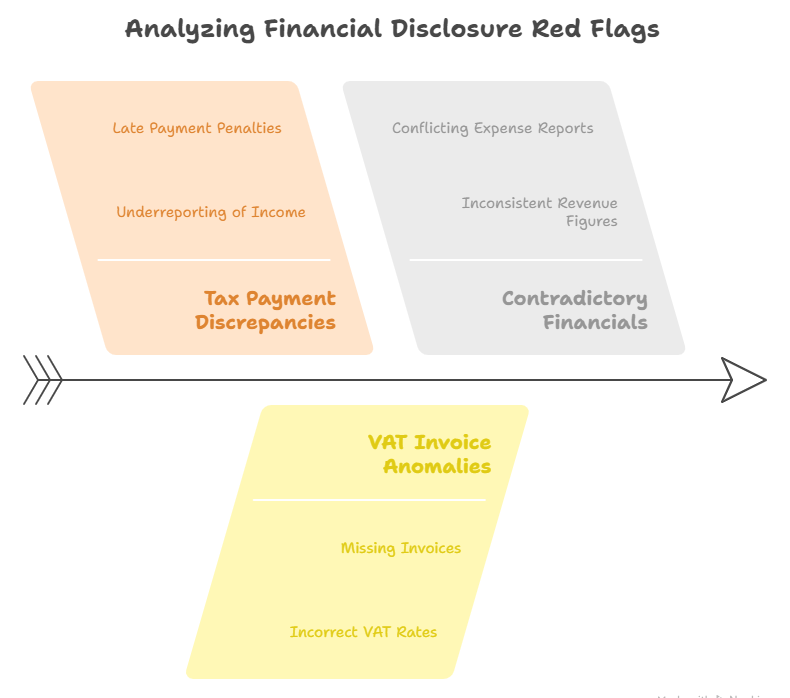For global businesses partnering with Chinese companies, financial transparency isn’t just desirable—it’s critical for risk mitigation. While China’s State Administration of Taxation has strengthened enforcement (collecting ¥1.35 trillion in back taxes in 2023 alone), tax non-compliance remains a concern. Official Enterprise Credit Reports (ECRs) and VAT invoices reveal vital clues when cross-referenced—a due diligence step many international firms overlook. Here’s how to decode these documents:

Critical Red Flags in Financial Disclosures
- Tax Payment Discrepancies:
ECRs disclose corporate income tax payments under “Tax Payment Information.” Compare this with VAT invoice volumes. A company reporting ¥10M in annual sales but only ¥200,000 in taxes raises immediate questions.
Example Calculation:Expected Tax = Annual Sales × Industry Avg. Tax Rate (e.g., 25%) Significant Deviation = Red Flag - VAT Invoice Anomalies:
- Mismatched Entity Details: Verify uniformity in company names, tax IDs, and bank accounts across invoices and ECRs. Discrepancies may indicate fake transactions.
- Illogical Sequences: Genuine VAT invoices (发票, fāpiào) have consecutively numbered codes. Gaps or duplicates suggest manipulation.
- Contradictory Financials:
ECRs may list “profitable” status while showing negligible revenue taxes. Similarly, invoices declaring high-value transactions with no corresponding ECR revenue entries signal underreporting.
Case Study: Detecting Inconsistencies
A European machinery importer reviewed a supplier’s ECR and invoices:
- ECR Claim: Annual revenue ¥50M, tax paid ¥1.2M (effective rate: 2.4%)
- VAT Invoices: Showed ¥80M in sales to 5 shell companies (all registered at virtual addresses)
Outcome: Verification revealed unreported revenue streams and tax evasion. The importer terminated the contract, avoiding potential liability.
Proactive Verification Strategies
- Triangulate Data Sources:
Cross-reference ECR tax data with:- VAT invoice amounts
- Industry benchmarks (e.g., average tax rates for manufacturing: 20-30%)
- Public procurement records (if applicable)
- Scrutinize Supply Chains:
Validate VAT invoices of subcontractors. Fraud often occurs through fictitious suppliers. Use Official Enterprise Credit Reports to confirm their operational status and tax compliance. - Monitor Changes:
Sudden drops in ECR-reported taxes without revenue declines warrant investigation. Track quarterly updates via the National Enterprise Credit Information Publicity System (公示系统).
When Evidence Demands Action
If discrepancies emerge:
- Request Clarification: Ask partners for documented explanations.
- Audit Clauses: Ensure contracts mandate third-party audits.
- Report Anomalies: Submit findings to Chinese tax authorities via 12366.cn.
Regulatory Context:
China’s 2024 Company Law (Article 217) mandates accurate financial disclosures. Violations incur penalties up to ¥200,000 and blacklisting.
Why Specialized Verification Matters
Generic financial reviews miss culturally nuanced red flags—like “阴阳合同” (yīnyáng hètóng, dual contracts showing different transaction values). ChinaBizInsight’s Financial & Tax Credit Reports integrate VAT invoice analysis with ECR data, identifying inconsistencies invisible to standard checks. For high-risk engagements, combine with Executive Risk Reports to assess leadership integrity.
Protect your operations—turn document scrutiny into strategic insight.
Verify Chinese partners with confidence →
